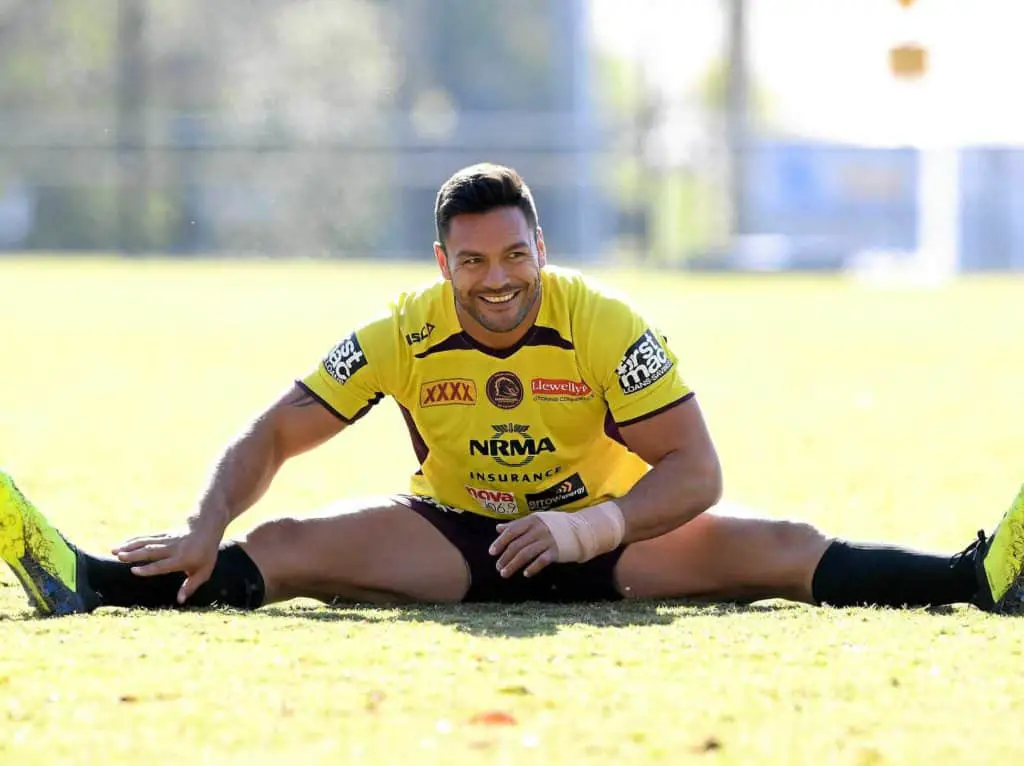
When you think of rugby league players your first thought is probably not related to their daintiness and flexibility. There appears to be a juxtaposition between 100kg plus rugby league league players covered in ugly tattoos and sporting even worse haircuts and the grace of bendy gymnasts and ballet dancers. However, just like a dancer or gymnast requires high amounts of flexibility and mobility so do rugby league players.
Why is flexibility important in rugby league?
Flexibility is important in rugby league because greater levels of flexibility are associated with lower levels of injury and soreness, high levels of power output and quicker sprint times. Flexibility is a key component of athleticism and can improve rugby league players’ performance on the pitch.
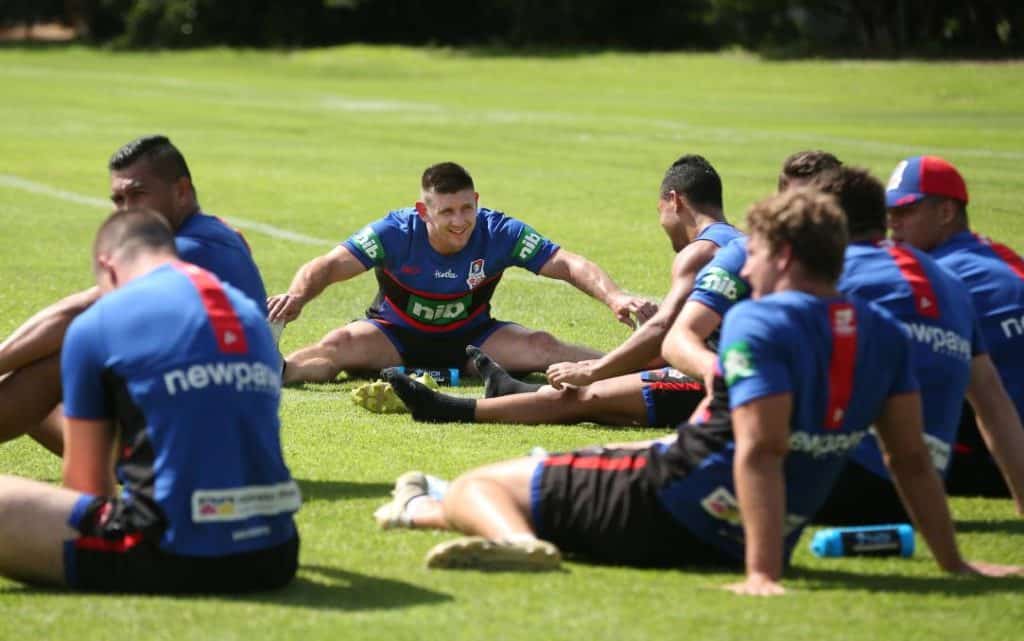
If you want to be a top rugby player you need to develop your flexibility. It might not be as cool as deadlifting 300kg but trust me working on your flexibility will have a profound effect on your onfield performance.
Increasing your flexibility has the ability to increase your power, speed and reduce your risk of suffering an injury.
You may be thinking how the hell can touching my toes or increasing my shoulder mobility make me tackle harder? Well, flexibility allows your body to get into ideal positions to express your strength. If you are the strongest man in the world but you are too stiff to get into the correct position when tackling you will hit like a girl.
On the other hand if you have high levels of flexibility which easily allows you to drop your body weight, squat down with your weight on your backfoot while standing in a staggered stance and you combine this with the strength you have developed weight training you will be capable of large amounts of power and delivering bone crushing tackles.
Flexibility won’t just help you make soul destroying tackles it will also make you faster. Yes, that is correct rugby league players who have higher levels of flexibility are faster than their fellow stiffer players. High levels of flexibility allow you to reach optimum stride length when sprinting while also allowing you to get maximum power transfer from the ground.
Being flexible also increases your smoothness as when running as your hips, knips, groin and hamstring can achieve an ideal range of motion, resulting in improved running style and mechanics. A smoother running style will knock off valuable time on your sprints.
An athlete’s flexibility levels can significantly impact their chance of being injured. With rugby league players who have higher levels of flexibility being less susceptible to injuries. If a joint or muscle is highly flexible it is more adept at dealing with the stress of rugby league where players are having their body parts regularly contorted when they make contact with other players during tackles or are pushing their muscles and joints to their edge when sprinting.
An inflexible joint or muscle is less able to deal with these stresses and is more likely to tear or be hyperextended, resulting in an injury occurring.
If you want to be a faster, more powerful rugby league player who is less likely to be injured then you need to be working on your flexibility particularly on your shoulder, groin, hip, hamstring, knee and ankle flexibility.
How To Improve Flexibility For Rugby League?
To improve flexibility for rugby league you should perform dynamic and ballistic stretching in the morning and pre-workout as they increase range of motion without affecting power output. You should perform isometric and static stretching post-workout to work on increasing permanent flexibility.
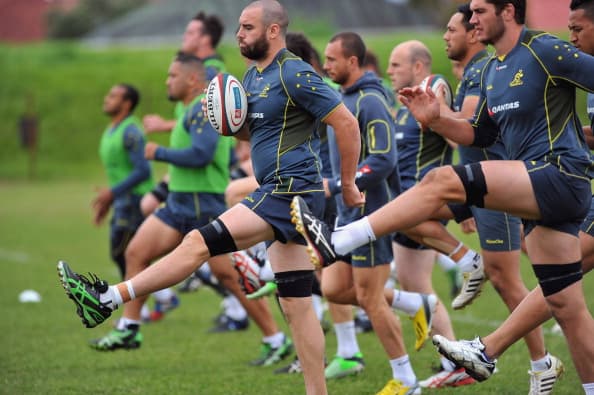
Ballistic stretching uses momentum to force a joint to move such as bouncing and singing motions. Ballistic stretching is controversial as it has a reputation for causing injuries due to athletes violently forcing their joints past their normal range of motion. However, when done in a controlled manner ballistic stretching is not only safe but effective in increasing discomfort free range of motion in athletes.
An example of ballistic stretch for a rugby league player to help warm up the quadriceps would be:
Lie on stomach
Grab foot and pull towards butt until heel touches
Hold for 30 seconds
Switch legs
When performing ballistic stretching before a workout you should stay within your comfortable range of motion and use slow and controlled bounces and swings.
Dynamic stretching involves stretching your muscles and joints through a whole range of motion using circular motions and sport specific movements. The goal of dynamic stretching is to mobilise the joint and increase the smoothness of movement, shaking off any stiffness or discomfort.
Instead of waiting for your body to wake up, dynamic stretching can be used to make your body more alert and prepare it for the work out. Dynamic stretching should be performed prior to your warm up.
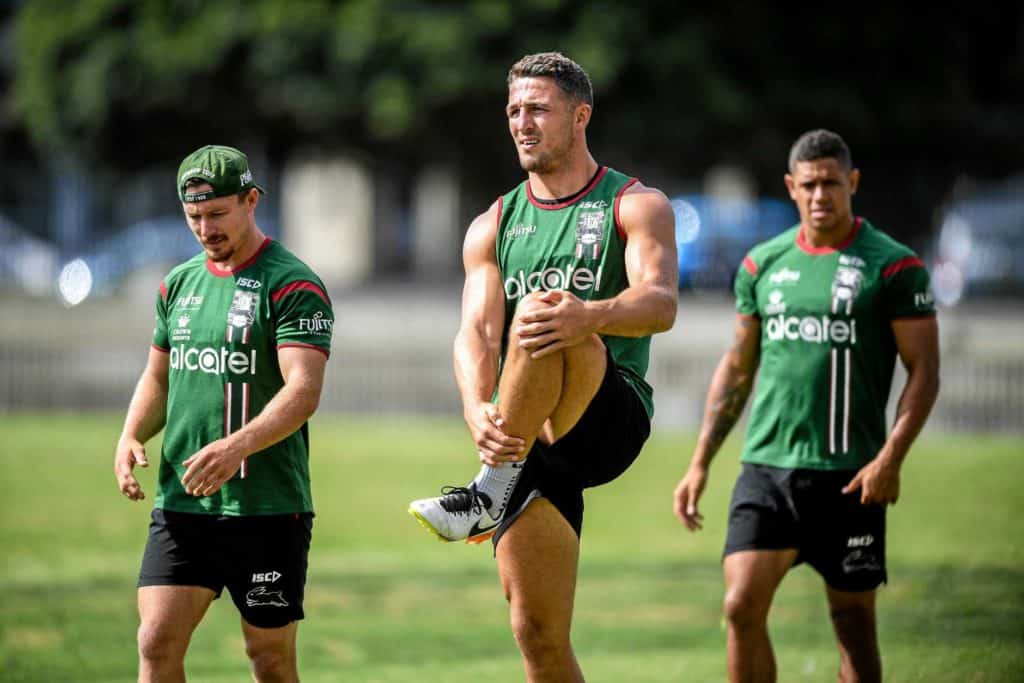
An Example Of Dynamic Stretches For Rugby League Players:
1. High Knees – raise knees to chest
2. Kick Backs – bring your heel to your butt
3. Knee Circles – bring knee out to the side, parallel with the floor, and then into the middle of your body and down.
4. Skipping – skip high into the air, roll your shoulder up and over to get more height
5. Carioca – move horizontally while lifting and bringing your inside leg over your outside leg, you should be twisting your back as you perform these
6. Bear walk – get on all fours and move forward, knees and stomach do not touch the ground
7. Run Hand Across Ground – as you are jogging bend down and run hand across the ground, keep a straight back and squat
8. Hopping – bounce around on one leg, can you hop the spot or move in different directions
9. Chest Hug – jump and hug your knees as you are in the air
10. Straight Leg Run – run forwards but keep your legs extended, use arms to propel you forward
After you have finished your rugby training is when you want to perform static stretching. The goal of static stretching is to make permanent gains in flexibility. Studies have shown that static stretching is the most effective way to permanently improve your joint and muscle range of motion.
One in depth study compared static stretching, self stretching and Proprioceptive Neuromuscular Facilitation stretching to a control group. The athletes performed a thirty-second stretch three times a week over the course of 4 weeks. The results showed that athletes who performed static stretching developed an increase in hamstring range of motion in comparison to the control athletes.
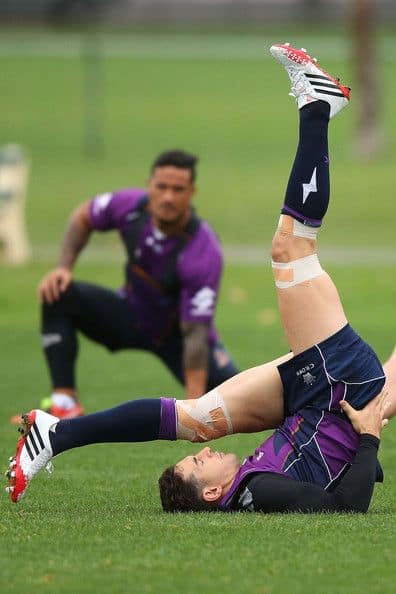
Rugby league players should focus on static stretches that target the lower limbs (knees, groin, ankles, hip and hamstrings) as these are susceptible to injuries and vitally important in developing sprinting speed.
Rugby league players should also focus on stretching the neck due the prevalence of head injuries and shoulders as during tackles the shoulders are placed under significant stress.
You should avoid performing static stretches prior to rugby training as studies have shown that static stretching decreases power output when performed prior to athletic training and competition.
Conclusion
Flexibility is one of the main athletic components of rugby league. It is often overshadowed by speed and strength, however it is just as important. Flexibility can help rugby league players increase their power, speed and reduce your likelihood of suffering an injury.
To develop flexibility athletes should perform dynamic and ballistic stretching prior to rugby training to warm up the body and then static stretching after training to make permanent flexibility gains.
